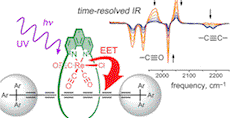Photophysics of Threaded sp-Carbon Chains: The Polyyne is a Sink for Singlet and Triplet Excitation

Abstract
We have used single-crystal X-ray diffraction and time-resolved UV–NIR–IR absorption spectroscopy to gain insights into the structures and excited-state dynamics of a rotaxane consisting of a hexayne chain threaded through a phenanthroline macrocycle and a family of related compounds, including the rhenium(I) chlorocarbonyl complex of this rotaxane. The hexayne unit in the rhenium-rotaxane is severely nonlinear; it is bent into an arc with an angle of 155.6(1)° between the terminal C1 and C12 atoms and the centroid of the central C–C bond, with the most acute distortion at the point where the polyyne chain pushes against the Re(CO)3Cl unit. There are strong through-space excited-state interactions between the components of the rotaxanes. In the metal-free rotaxane, there is rapid singlet excitation energy transfer (EET) from the macrocycle to the hexayne (τ = 3.0 ps), whereas in the rhenium-rotaxane there is triplet EET, from the macrocycle complex 3MLCT state to the hexayne (τ = 1.5 ns). This study revealed detailed information on the short-lived higher excited state of the hexayne (lifetime ∼1 ps) and on structural reorganization and cooling of hot polyyne chains, following internal conversion (over ∼5 ps). Comparison of the observed IR bands of the excited states of the hexayne with results from time-dependent density functional calculations (TD DFT) shows that these excited states have high cumulenic character (low bond length alternation) around the central region of the chain. These findings shed light on the complex interactions between the components of this supramolecular rotaxane and are important for the development of materials for the emerging molecular and nanoscale electronics.